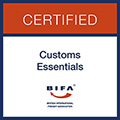How to calculate import duty on Chinese goods?
Import Duty from China to the UK
Navigating the complexities of importing goods from China to the United Kingdom can be daunting, particularly when it comes to understanding import duties and taxes. Import duty is a crucial aspect of international trade, as it directly affects the overall cost of goods. This article aims to provide a comprehensive guide on calculating import duty for products imported from China, ensuring that businesses and individuals are well-informed and prepared for the financial implications of their imports.
Understanding Import Duty
Import duty is a tax levied on goods brought into a country from abroad. In the UK, the import duty is determined by several factors, including the type of goods being imported, their value, and the country of origin. The primary purpose of import duties is to protect domestic industries by making foreign goods more expensive, thereby encouraging consumers to purchase locally produced items.
The Importance of Knowing Import Duty
Understanding import duty is essential for several reasons:
- Cost Management: Import duties can significantly affect the total landed cost of goods. By accurately calculating these costs, businesses can make informed pricing decisions.
- Compliance: Importers must adhere to UK customs regulations. Failing to pay the correct amount of duty can result in fines, delays, and even confiscation of goods.
- Budgeting: Knowing the import duty helps businesses plan their budgets more effectively, ensuring that they allocate sufficient funds for taxes and duties.
Key Components of Import Duty Calculation
When calculating import duty on goods imported from China, several components must be considered. These include:
- Customs Value
The customs value is the total value of the goods being imported. This value typically includes:
- Cost of Goods: The purchase price of the goods.
- Shipping Costs: Any transportation costs incurred to bring the goods to the UK.
- Insurance Costs: Any insurance fees associated with the shipment.
- Duty Rate
The duty rate is the percentage applied to the customs value to determine the import duty. This rate varies depending on the type of goods and their classification under the UK Trade Tariff. Importers can find the applicable duty rates by consulting the UK Trade Tariff online.
- VAT (Value Added Tax)
In addition to import duty, VAT is also applicable on imported goods. The standard VAT rate in the UK is currently 20%. VAT is calculated on the total of the customs value plus the import duty.
How to Calculate Import Duty: Step-by-Step Guide
Calculating import duty may seem complex, but it can be broken down into a series of straightforward steps:
Step 1: Determine the Customs Value
To begin, gather all relevant information regarding the goods being imported. This includes the purchase price, shipping costs, and any insurance fees. Add these amounts together to establish the customs value.
Example Calculation:
- Cost of Goods: £1,000
- Shipping Costs: £200
- Insurance Costs: £50
Customs Value = £1,000 + £200 + £50 = £1,250
Step 2: Identify the Duty Rate
Next, consult the UK Trade Tariff to find the appropriate commodity code for the goods you are importing. This code will help you identify the applicable duty rate.
For example, if the duty rate for your goods is 5%, you would calculate the import duty as follows:
Import Duty = Customs Value × Duty Rate
Import Duty = £1,250 × 5% = £62.50
Step 3: Calculate VAT
Once you have determined the import duty, you can calculate VAT. The VAT is applied to the total of the customs value and the import duty.
VAT Calculation:
- Total Value for VAT = Customs Value + Import Duty
- Total Value for VAT = £1,250 + £62.50 = £1,312.50
VAT = Total Value for VAT × VAT Rate
VAT = £1,312.50 × 20% = £262.50
Step 4: Calculate Total Landed Cost
Finally, add the customs value, import duty, and VAT to determine the total landed cost of the goods.
Total Landed Cost = Customs Value + Import Duty + VAT
Total Landed Cost = £1,250 + £62.50 + £262.50 = £1,575
Documentation Required for Importing Goods
When importing goods from China, it is essential to prepare the necessary documentation to ensure smooth customs clearance. Key documents include:
- Commercial Invoice
A commercial invoice is a vital document that provides details about the transaction, including the buyer and seller information, a description of the goods, their value, and payment terms.
- Packing List
The packing list outlines the contents of the shipment, including the quantity and type of items packed. This document is crucial for customs officials to verify the shipment.
- Bill of Lading
The bill of lading serves as a receipt for the goods and provides details about the shipment, including the shipping method and carrier information.
- EORI Number
An Economic Operator Registration and Identification (EORI) number is required for customs clearance in the UK. Importers must obtain this number before shipping goods.
Common Mistakes to Avoid
When calculating import duty and navigating the import process, several common mistakes can lead to complications:
- Incorrect Valuation of Goods
Underestimating the customs value can result in underpayment of duties and taxes, leading to fines or delays. Always ensure that the customs value accurately reflects the total cost of the goods.
- Failing to Classify Goods Properly
Misclassifying goods can result in applying the wrong duty rate. It is essential to consult the UK Trade Tariff and use the correct commodity code to avoid this mistake.
- Neglecting VAT
Some importers overlook VAT when calculating the total landed cost. Remember to include VAT in your calculations to avoid unexpected expenses.
Penalties for Non-Compliance
Failing to comply with import regulations can lead to severe penalties. Common consequences include:
- Fines
Importers may face substantial fines for underreporting the customs value, misclassifying goods, or failing to pay the appropriate duties and taxes.
- Delays
Non-compliance can lead to delays in customs clearance, resulting in longer shipping times and potential damage to business relationships.
- Seizure of Goods
In severe cases, customs authorities may seize imported goods if they suspect fraudulent activity or non-compliance with regulations.
Resources for Importers
To facilitate the import process and ensure compliance with regulations, various resources are available:
- HM Revenue and Customs (HMRC)
The UK government’s HMRC website provides comprehensive information on import duties, VAT, and customs regulations. Importers can access the UK Trade Tariff and other essential resources.
- Customs Agents
Hiring a customs agent can simplify the import process. These professionals can assist with documentation, compliance, and navigating the complexities of customs regulations.
- Online Calculators
Numerous online import duty calculators can help estimate duties and taxes based on the value of goods and their classification. These tools can save time and reduce errors in calculations.
Conclusion
Understanding and calculating import duty on goods imported from China to the UK is essential for businesses and individuals involved in international trade. By following the outlined steps and being aware of the necessary documentation and potential pitfalls, importers can ensure compliance and avoid costly mistakes. With the right knowledge and resources, navigating the import process can be a straightforward and successful endeavour.
Import Duty from China to the UK. Customs clearance with DCP Logistics
Import duty from China to the UK
If you have decided to co-operate with our customs agency DCP Logistics, then call or use the contact form.
Phone: +44 20 7846 6253
Email: info@dcp-co.uk
Website: https://dcplogisticsgroup.co.uk
Contact to DCP Logistics






